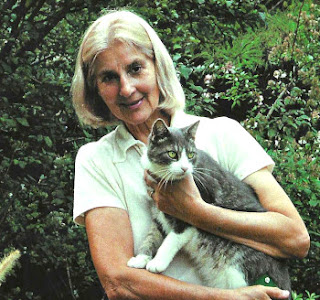Pamela Harper died on July 14th at the age of 93. She was one of the greats in the world of horticulture, authoring five books as well as documenting plants and gardens in over 100,000 photographs.
A native of England, she first became interested in gardening in 1955 when she and her husband Patrick purchased a house on an acre of land. The twelve years spent making that garden was chronicled in her first book, The Story of a Garden, published in 1972. In the introductory chapter, she said that neither she nor her husband had gardened before and didn't have an inclination to do so but "what began from necessity became a deeply satisfying hobby." For some gardeners, that "hobby" can become an obsession and that was the case with Pam as she began reading magazines, books and visiting gardens (Windsor Great Park, an hour's drive, was a favorite) to learn all she could on the subject.
 |
| Pam's first garden (from "The Story of a Garden") |
In 1968, Patrick was offered a job in the United States and they would eventually settle in Seaford, Virginia on the Virginia Peninsula in 1971. Here, on a sandy, oblong-shaped two acres, she would create her new garden, a densely planted living laboratory of plants that she evaluated, photographed and wrote about. Every plant that entered her garden was documented in a card file with pertinent information such as the source, date, location in the garden and most important of all, how it behaved.
Pam was an accomplished photographer and her photos would not only illustrate her own books but be licensed through her company "Harper Horticultural Library" which was one of the largest horticultural photographic collections in the country. One of Pam's specialties was combining plants in striking color and textural combinations. She would illustrate these concepts in her books Designing With Perennials (1991) and Color Echoes (1994). She once told me that she constantly moved plants around in her garden until she found the most pleasing combinations.
Her last book, Time Tested Plants: Thirty Years In A Four-Season Garden is my personal favorite. It is a selection of plant profiles that were the best performers in her garden. Although she was extremely unhappy with the way the publisher designed the book (and it is a difficult book to hold comfortably), it contains a wealth of knowledge expressed in her beautiful conversational tone with occasional doses of her wry wit. The book was a huge influence on me. Even though I lived hundreds of miles to the south from her, we gardened in the same zone and the plants that flourished for her usually did so in my garden.
 |
| Meeting Pam at one of her lectures in Memphis Tennessee, October 2010 |
I first met Pam in October of 2010 when I attended a lecture she gave ("Hydrangeas and their Companions") for the Mid-South Hydrangea Society in Memphis, Tennessee. In May of 2012, Michael and I got to visit Pam's garden, an absolutely thrilling experience. She was warm and embracing and I was enthralled that evening after dinner (she made us Chicken Tetrazzini) when she shared stories about her life, garden, experiences with publishing her books and some funny stories about hobnobbing with many of the great British gardeners (Christopher Lloyd, Rosemary Verey, etc. - she knew them all!). We were also quite impressed with the talents of her late husband Patrick, who apparently had many interests. She showed us furniture he had made for their home and a closet-full of clothes that he had sewn for her (as you can imagine, Michael was quite floored by that).
 |
| A photo I took of Pam's garden when I visited in 2012 |
Following that visit, Pam and I stayed in touch by e-mail. Her e-mails were always a treat. She would begin by describing the highlights of the current garden and the weather. We would also discuss other things - baking, health, house and garden expenses, gardening catalog offerings, politics and what we were reading. During the past years, her eyesight began to fail and she was relying on audiobooks for her entertainment.
She was concerned with finding a home for her 100,000 garden slides. I had contacted HPSO and the Miller Library for her but they could not use them. She was relieved when she sold 75,000 slides to a company teaching design (I don't know who this was). The remaining slides were eventually donated to the JC Raulston Arboretum.
If my G-mail archive is correct (and anyone who uses G-mail probably knows how frustrating finding old e-mails can be there), our last correspondence was from the previous summer. Although her eyesight had gotten worse, she still gardened and said that she went out about 6:30 in the morning and worked for 3 hours. She was complaining about the heat and commenting that people in Europe and the PNW would be installing air conditioners and exasperating the climate situation. "I find myself fiddling while Rome burns" she said.
She will be dearly missed by the horticultural community. I've heard her house will go on the market soon. I do hope that her beloved garden can somehow be preserved.





She sounds so lovely, thank you for sharing. I'm ordering Time Tested Plants now. ~Tracy
ReplyDeleteThat's a wonderful tribute to a remarkable woman, Phillip. I've had 'Color Echoes' in my collection of garden books for decades and still remember its impact on me.
ReplyDeleteHow fortunate you were to have such a nice friendship. Your tribute to her is lovely and I appreciate the efforts you made to find a home for her slides, even though it didn't work out. I hope the new owners will appreciate and love her garden - it's scary, isn't it?
ReplyDelete